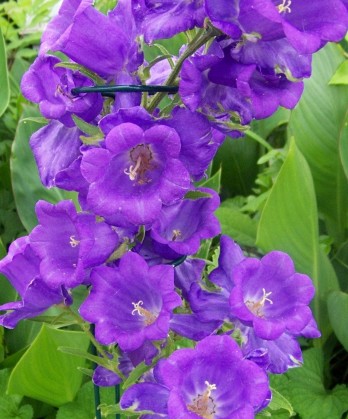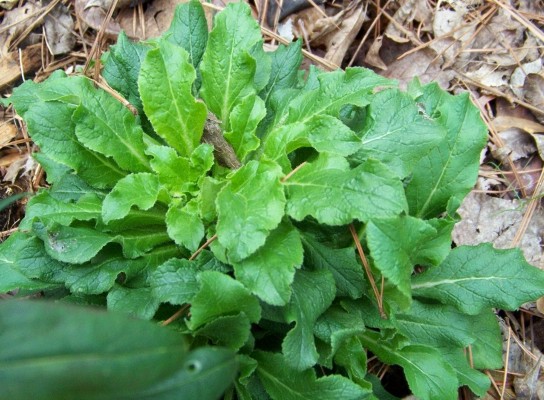|
Gardens Ablaze |
||
|
|
Canterbury
Bells
|
|
|
Detailed Biennial Profiles Site Map
Home
|
Canterbury bells can come in white and pink in addition to the purple pictured above, but I personally really like the purple. The picture doesn't do it justice. My plant grew to nearly 4 feet tall and was absolutely covered with these purple bell-shaped blooms. As you can see from the picture, this is a plant that will require staking, especially if you want to use the stalks for cut flowers. I wasn't ready for that this time around since I didn't even know what it was until it bloomed, and as you can see, the plant leaned heavily toward the right even after staking, especially after rain. I'm going to get bigger stakes next season and put them in place early.
I haven't noticed any self-seeding so far despite the fact that after the flowers were spent I cut the stems off with seeds intact and buried them in the garden bed but it's early yet and hope springs eternal. If I don't have any volunteers, you can bet I will hunt down a packet of seeds and try my hand that way. This is a plant I will make an effort to keep producing from now on. In many ways, Canterbury Bells remind me of Foxglove and do seem to have the same growing requirements. In fact, my Canterbury Bells made their debut in the middle of the only bed I grow Foxgloves in. Therefore, if you have ever grown Foxglove, you know what to do with Canterbury Bells. If you are not lucky enough to have a Canterbury Bell plant dropped like manna from heaven into your Foxglove garden, you will probably have to start them from seed. I don't think I have ever seen Canterbury Bell plants at any garden store, even the specialty ones. I do a lot of seeding every year, and always do mine in flats with potting soil. The reason for this is that I have a lot of stuff out there in the garden and a lot of weeds too, and I am notorious for pulling good seedlings out along with bad weeds. As a result, I start everything in flats and then transplant when they are recognizable so I'm not constantly working against myself. Canterbury Bell seeds need light to germinate, so whether you direct seed or seed in flats, just press the seed in (don't cover with soil), and keep the soil moist until you see those little sprouts coming to life. I usually wait at least until I see the first true leaves before planting in the garden. Give the seedlings plenty of sun once they are up so they don't get spindly. As always, once they are on their way in the garden, mulch, mulch, mulch. Do remember though, that unless you do all this in the fall, you will only see a clump of foliage the first season and no blooms until the year after that, which is a long wait. But planting in the fall has drawbacks too. You might lose the plant altogether during a harsh spell in winter. So it's a crapshoot, but just remember, you are in for a real treat when Canterbury Bells finally do grace you with blooms, and you will fool your friends into thinking you actually have some idea of what you are doing - always great fun. So that's it, folks. This one is on my highly recommended list and is at the easy end of the gardening skill scale even from seed. So find a pack of Canterbury Bell seeds as soon as you can and then go plant 'em!
Custom Search
|
|
|
Gardens Ablaze |
||
 Canterbury
Bells are not a plant I see every day in home gardens in my area. All the
more reason to grow them, right? I wish I had thought of that, but
in all honesty I can't take credit. A clump of Canterbury Bells just
magically appeared in my garden last year, and I really don't know where
it came from. I noticed a strange clump of something in early spring
as I did some cleanup in one of my garden beds. I knew it wasn't a
weed, but had no idea what it was, so I just left it alone until finally
it sent up flower stalks and started blooming. Lucky me! A picture
of that very plant is to the right, and what a nice plant it is with it's
noticeably bell-shaped, spectacularly royal purple flowers.
Canterbury
Bells are not a plant I see every day in home gardens in my area. All the
more reason to grow them, right? I wish I had thought of that, but
in all honesty I can't take credit. A clump of Canterbury Bells just
magically appeared in my garden last year, and I really don't know where
it came from. I noticed a strange clump of something in early spring
as I did some cleanup in one of my garden beds. I knew it wasn't a
weed, but had no idea what it was, so I just left it alone until finally
it sent up flower stalks and started blooming. Lucky me! A picture
of that very plant is to the right, and what a nice plant it is with it's
noticeably bell-shaped, spectacularly royal purple flowers.  Canterbury
bells are usually considered to be biennials - they grow a clump the
first year and then flower and die in the second year. Not so in
my case. My plant not only made it through the winter but the
clump is twice as big as it was last year in my zone 7 garden. See
picture taken in mid February, 2012. Admittedly we had a very warm
winter that year, but I'm feeling kind of confident that this plant will
be around for a few years to come, which would make it a tender biennial
or perennial in my neck of the woods. Obviously, since it just
magically appeared in my garden one day, my Canterbury Bell has had no
special treatment as far as soil or watering, but it did happen to take
up residence in a reasonably well-kept bed with pretty average soil but
that gets regular mulching, weeding, watering, and fertilizing all year
round. I have heard that Canterbury Bells will grow spindly and
weak if they are pampered too much so my advice is just leave them alone
other than the basics. As far as sun, mine get about half a day of
sun, mostly in the morning and the result has been good. This is
definitely not a shade plant, but as with a lot of other plants, the
further south you are, the more shade it will tolerate.
Canterbury
bells are usually considered to be biennials - they grow a clump the
first year and then flower and die in the second year. Not so in
my case. My plant not only made it through the winter but the
clump is twice as big as it was last year in my zone 7 garden. See
picture taken in mid February, 2012. Admittedly we had a very warm
winter that year, but I'm feeling kind of confident that this plant will
be around for a few years to come, which would make it a tender biennial
or perennial in my neck of the woods. Obviously, since it just
magically appeared in my garden one day, my Canterbury Bell has had no
special treatment as far as soil or watering, but it did happen to take
up residence in a reasonably well-kept bed with pretty average soil but
that gets regular mulching, weeding, watering, and fertilizing all year
round. I have heard that Canterbury Bells will grow spindly and
weak if they are pampered too much so my advice is just leave them alone
other than the basics. As far as sun, mine get about half a day of
sun, mostly in the morning and the result has been good. This is
definitely not a shade plant, but as with a lot of other plants, the
further south you are, the more shade it will tolerate.